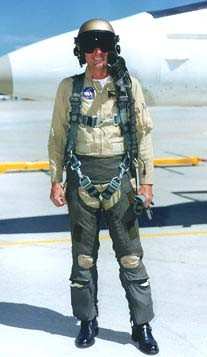Inventor Of G-Suit Dies Was 97
 Aero-News has learned Earl Wood,
M.D., Ph.D., the Mayo Clinic investigator credited with inventing
the high-altitude pressure suit worn by pilots and astronauts, died
March 18 in Rochester, MN. He was 97.
Aero-News has learned Earl Wood,
M.D., Ph.D., the Mayo Clinic investigator credited with inventing
the high-altitude pressure suit worn by pilots and astronauts, died
March 18 in Rochester, MN. He was 97.
"As both a physician and researcher, Dr. Wood provided nearly
five decades of outstanding leadership to Mayo Clinic and
scientific advancements to the world," says Denis Cortese, M.D.,
Mayo Clinic president and CEO. "His achievements made manned
spaceflight possible and contributed to American national defense
since WWII. His legacy of discovery will benefit society for
decades to come."
Wood was born January 1, 1912, in Mankato, MN. A 1934 graduate
of Macalester College, he also earned an additional bachelor's
degree, master's degree, as well as Ph.D. and M.D. degrees from the
University of Minnesota. After serving as a National Research
Council fellow at the University of Pennsylvania, he taught
Pharmacology at Harvard University where he met Charles Code, M.D.,
who offered him a position at Mayo Clinic.
From 1942, Dr. Wood was an integral member of the Mayo Clinic
Aero Medical Unit, which developed the first civilian human
centrifuge in the United States. The centrifuge was used to test
human reactions to high levels of gravitational forces. The team of
Drs. Wood and Code, and Drs. Edward Lambert and E.J. Baldes tested
the centrifuge themselves, risking their personal safety to
safeguard others involved in their research.
They followed the same "do no harm" approach when, later, they
tested equipment inside aircraft. Barry Gilbert, Ph.D., a Mayo
physiologist who worked with Dr. Wood, says this group didn't
hesitate to be their own "guinea pigs."
"People need to appreciate that for four years Dr. Wood and his
colleagues got up every day and risked their lives in the service
of their country," says Dr. Gilbert.
In large part, their top secret work laid the foundation for the
science behind modern aerospace physiology and made travel possible
in the upper levels of the atmosphere and outer space. WWII bomber
pilots, jet fighter pilots, the test pilots who broke the sound
barrier, and today's astronauts wore the suit, in various
versions.
 The group quickly gained an international reputation that
extended to heart, lung and blood physiology and cardiac
catheterization. "Dr. Wood was absolutely instrumental in the
development of cardiopulmonary bypass, a technology that saves
hundreds of thousands of lives every year," says Thoralf Sundt III,
Mayo Clinic surgeon.
The group quickly gained an international reputation that
extended to heart, lung and blood physiology and cardiac
catheterization. "Dr. Wood was absolutely instrumental in the
development of cardiopulmonary bypass, a technology that saves
hundreds of thousands of lives every year," says Thoralf Sundt III,
Mayo Clinic surgeon.
In 1958, research using the centrifuge got a second boost when
the US Air Force and NASA requested that Dr. Wood continue his
studies on G forces. He and his team tested prototypes of the
Project Mercury astronaut couches on Mayo's centrifuge.
Wood published over 700 articles and numerous book chapters. He
was president of the American Physiological Society from 1980 to
1981, and president of the Federation of American Societies of
Experimental Biology. He was a fellow of the National Research
Council. Dr. Wood retired from Mayo Clinic in January 1982.
 ANN's Daily Aero-Linx (05.02.24)
ANN's Daily Aero-Linx (05.02.24) ANN's Daily Aero-Term (05.02.24): Touchdown Zone Lighting
ANN's Daily Aero-Term (05.02.24): Touchdown Zone Lighting Aero-News: Quote of the Day (05.02.24)
Aero-News: Quote of the Day (05.02.24) ANN FAQ: Contributing To Aero-TV
ANN FAQ: Contributing To Aero-TV NTSB Final Report: Cirrus Design Corp SR20
NTSB Final Report: Cirrus Design Corp SR20




